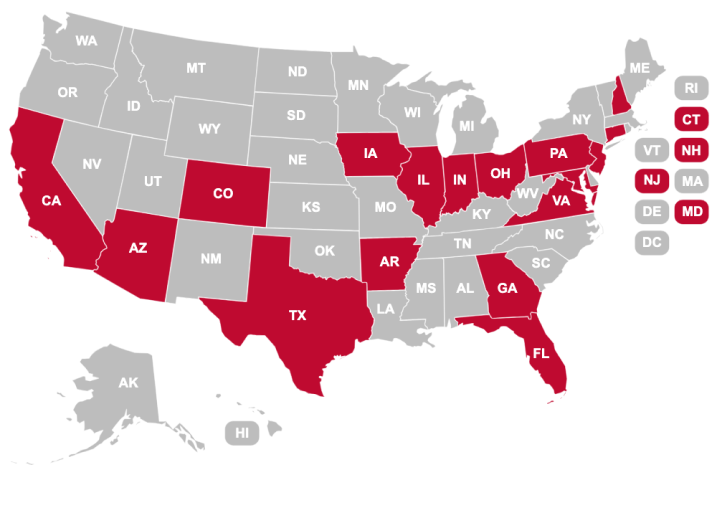401a vs 403b Comparison: Advantages & Contribution Limits

h2,h3
When enrolling for a retirement plan, everyone ends up comparing 401a vs 403b. After all, both of these retirement plans have their own pros and cons. If you want to end up with a retirement plan that suits your needs and goals, you have to weigh these properly. And to help you with it, this blog is your guide. Therefore, read it till the end and you will have your 401a vs 403b comparison chart in no time…
“401a vs 403b are both employer-sponsored retirement plans that offer tax advantages.”
- 401a plans are sponsored by government, nonprofit, and educational institutions, while 403b plans are for public schools and tax-exempt organizations.
- Both 401a and 403b plans have a 2024 contribution limit of $69,000, combining employee and employer contributions.
- Contributions to both plans are tax-deferred, with taxes due upon qualified withdrawals at age 59 ½, and early withdrawals face a 10% penalty.
- Employers must contribute to 401a plans, whereas employer contributions to 403b plans are voluntary, with specific IRS rules for each.
401a vs 403b Advantages & Contribution Limit Update 2024
You should know that 401a vs 403b contribution limits and tax advantages are at high odds by 2024. Sure, there are similarities in both these retirement plans. But there are differences as well. So, we recommend that you also take a professional state pension advisor’s help. Undoubtedly, their retirement planning services will help you end up with the right plan from among the 403b vs 401a. Anyway, here’s all you need to know about these retirement plans.
What Is The Difference Between a 401a And a 403b Retirement Plan?
When it comes to 401a vs 403b, you should know that a 403(b) plan typically offers annuity options from insurance providers. Clearly, the 401a plan actively facilitates mutual fund investments – usually. Moreover, you should know that most colleges and universities offer attractive employer contributions. Anyway, here’s more on 401a vs 403b:
401a Retirement Plan
If you are familiar with the 401k retirement plan, 401a retirement plan is similar to it. After all, it works in just the same way. Typically, the sponsors of 401a plan are government agencies, nonprofit organizations, and educational institutions. However, the sponsors of 401k plan are usually private companies. Moreover, you should know that the sponsors of 401(a) plans enjoy greater control. Because the terms of plan structure are manageable, it is on the employers to set the eligibility requirements. What’s more, you should know that the employers usually make it mandatory for qualified employees to participate in the 401a retirement plan. After all, their main aim is to help their employees plan ahead for their retirement – plan ahead for providing tax incentives.
403b Retirement Plan
Now, let’s take a look at a 403b retirement plan to see which is better for you. Obviously, the main factor is the type of organization where you are employed. Undoubtedly, a 403b plan is best for the employees of 501(c)(3) organizations and public schools. Clearly, it is a tax-favored retirement plan for the employees of these organizations. Here are the organizations that mostly offer the 403b retirement plan:
- Public Schools
- 501(c)(3) tax-exempt organizations
- Medical Organizations
- Religious Institutions
Furthermore, you should know that the sponsors of 403(b) plans have the authority to set eligibility requirements.
In both 401a and 403b, the eligibility requirements are always set by the employer.
401a vs 403b: IRS Rules And Regulations
In case of 403b, the IRS usually requires the following account set ups:
- Custodial accounts (for mutual funds investment)
- Annuity contracts (with insurance companies)
- Retirement income accounts (for annuities or mutual funds investment)
Most importantly, you should know that the IRS has clear rules when it comes to 403b vs 401a. For example, in the case of the 401a, employers must contribute to their employees’ 401(a) plans. Therefore, this 401a retirement plan sort of entitles you to “free money.” After all, your employer is contributing to the retirement plan as well.
Sure, the employers have the freedom to make it optional for employees to make contributions. But they must contribute to the employees’ retirement plans themselves if they wish to stay compliant with the IRS rules and regulations. Moreover, if you go with 401a, your employers are allowed to defer a certain percentage of your paycheck and salary. Clearly, this deferment amount is added in the 401a retirement plan. What’s more, the structure of 401a plan gives the employees the option to make contributions to their 401(a) accounts or traditional pensions. If you are a government employee, you for sure have this option.
401a vs 403b: Tax Advantages in 2024
In terms of tax treatment, there is no 401a vs 403b. After all, both these plans almost function in the same way. If we talk about the 403b participants, there have to be contributions on a pretax basis. Clearly, your money will grow without being subject to tax if you choose this retirement plan. However, you should know that you will be required to pay regular tax on eligible withdrawals. This you can make at the age of 59 1⁄2. However, if you make an early withdrawal, you need to know that there will be a 10% penalty tax.
In much the same way, in 401a your employer will deduct your contribution from your salary – before the government cuts. But there’s more to it. First, you should know that the investment options depend on the employer. Second, the option are following:
- Stocks
- Mutual Funds
- Bonds (managed by reputable investment firms)
Furthermore, you should also know that the money grows without incurring taxes. And it remains in your 401a account. Therefore, this is not like a standard brokerage account. There’s no subject to your capital gains, interest, and dividends to tax each year. However, you must pay regular income tax when you’re able to make qualified withdrawals. And this is at the age of 59 ½. Just like 403b, there will be a 10% penalty tax if you withdraw it early.
401a versus 403b: Contribution Limit
If you want proper financial planning, a 401a versus 403b comparison chart is something you need to know. After all, it is highly possible that your employer might offer you both options to choose from. Anyway, to help you out, here are the contribution limits of 401a vs 403b:
401a Contribution Limit, 2024
The contribution limit for 401(a) plans is $69,000 in 2024. You should know that this limit applies to the combined total of employee and employer contributions. Moreover, you should also know that you and your employer can only contribute up to your total salary if your income is below this contribution limit. For example, say you earn $45,000 a year. In such a case, your employer and you are only allowed to contribute that amount to your 401(a) account for the year. This is because the contribution limit for 401(a) plans is $69,000 in 2024.
“The contribution limit for a 401(a) account is usually higher than that of other types of retirement plans.” – Forbes Advisor
403b Contribution Limit, 2024
Similarly to the 401a retirement plan, the contribution limit for 403(b) retirement plans is $69,000. And just as similarly to 401a, you should know that this limit applies to the combined total of employee and employer contributions. However, there’s a difference. The exact contribution amount can be reduced based on previous contributions – to the employer’s plan. For example, say you have worked with an employer for 15 years and contributed $75,000 or more to retirement plans with that employer. Then the employer may not be able to contribute more. The subject of “How to prepare for retirement?” is not an easy process. So, you need to take all these considerations into focus to make the most of your retirement planning.
IRS Rules on 403b Enrollment
If you go by the IRS rules, you can enroll in the 403b retirement plan after a maximum contribution of about to contribute a maximum amount of $23,000 in “elective deferrals” to your accounts in 2024. But if you are older in age, say more than 50 years old, and say that you have maxed your deferrals, then you can make a catch-up contribution of $7,500.
The money that’s deducted from your paycheck and put into your account is called the Elective deferrals.
Furthermore, you should know that your employer can contribute a maximum additional amount of $46,000 in 2024 if they are contributing to your 403(b) account. Clearly,this will bring the total contribution limit to $69,000. If you want to estimate how much you can contribute and grow your savings, you can use a 403b calculator to run different scenarios.
The IRS makes it mandatory for employers to contribute to their own employees' 401(a) plans. This rule applies even if the sponsor decides to make employee contributions optional.
401a vs 403b Comparison Chart
If you are still confused about 403b vs 401a, here is a 401a vs 403b comparison chart that can help you out. Clearly, we have simplified all the information regarding these retirement plans in this comparison chart. So, here’s all you need to know:
Ending Thoughts on 401a vs 403b
The subject of 401a vs 403b can be a bit complicated. After all, both these retirement plans have some similarities and differences. For example, the contribution limit is the same as 2024. But the age catch-up limits are different. In the same way, both these retirement plans gave tax-deferred contributions, but the employee and employer contributions have different terms. Thus, you need to know the overall 401a vs 403b comparison chart if you want to make an informed decision regarding your retirement planning. To simplify your decision, you can also try a 403b retirement calculator to project your potential retirement income and compare it against other plans.
Without knowing about the details of these retirement plans, you cannot choose the one that is more suited to your retirement needs and goals. Moreover, you should know that it is always wise to seek help from an expert advisor regarding retirement planning. At State Pension Advisors, we have the best experts to help you plan your retirement. Undoubtedly, you can reach out to us today to book your free consultation and meeting. We are always ready and happy to help you.










.png)
.png)



%20Beneficiary%20Everything%20You%20Should%20Know%20as%20a%20State%20Employee.jpg)
%20Plan%20Options%20Everything%20You%20Should%20Know.jpg)





